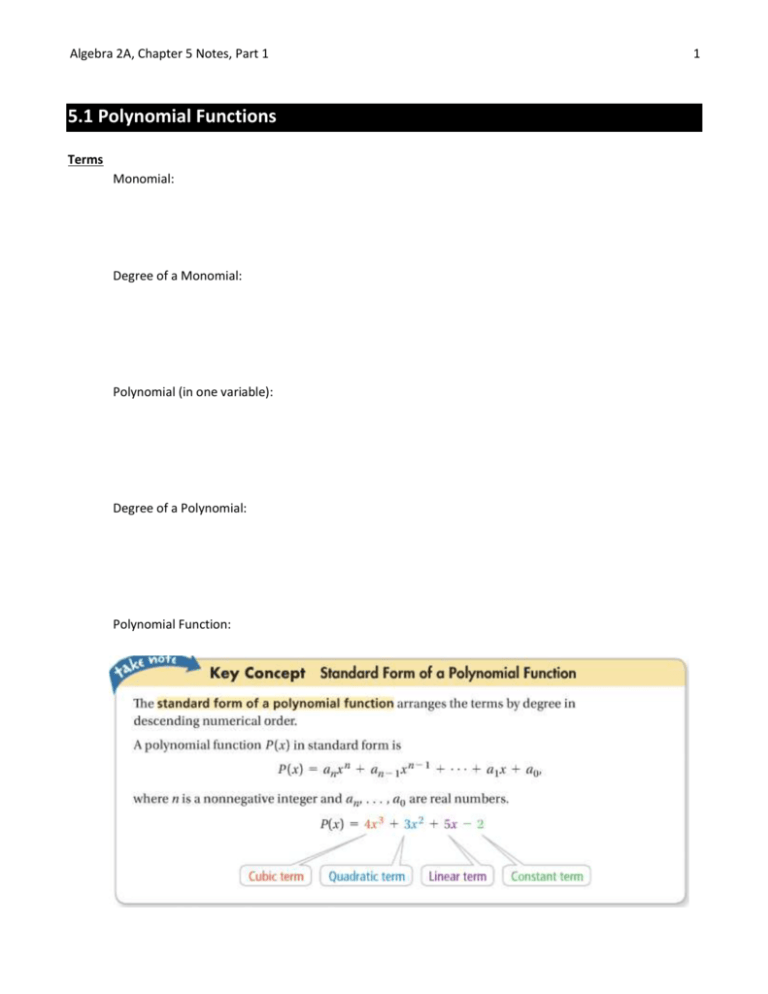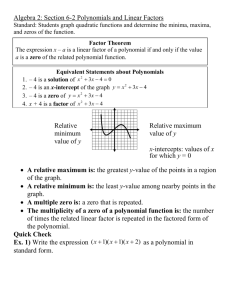5.1 Polynomial Functions
advertisement

Algebra 2A, Chapter 5 Notes, Part 1 5.1 Polynomial Functions Terms Monomial: Degree of a Monomial: Polynomial (in one variable): Degree of a Polynomial: Polynomial Function: 1 Algebra 2A, Chapter 5 Notes, Part 1 2 You can classify a polynomial l by its degree or its number of terms. Polynomials degree 0-5 have specific names. Degree: 0 constant 1 linear 2 quadratic 3 cubic 4 quartic 5 quintic Number of terms: 1 monomial 2 binomial 3 trinomial N Polynomial of “n” terms Examples: Example 1: Classifying Polynomials Write each polynomial in standard form. What is its classification by degree? By number of terms? A. 3𝑥 3 − 𝑥 + 5𝑥 4 D. 𝑥 2 − 4𝑥 2 B. 3 − 𝑥 5 + 2𝑥 2 + 10 E. 3 − 𝑥 + 10 C. 3𝑥 3 − 5 + 9𝑥 3 F. 3𝑥 − 𝑥 4 + 5𝑥 2 + 1 Algebra 2A, Chapter 5 Notes, Part 1 3 Degree of a Polynomial Function Affects the shape of the graph Affects the end behavior o End behavior: 4 Types of End Behavior (for functions of degree one or greater) You can determine the end behavior of a polynomial function of degree n from the leading term axn of standard form. Example 2: Describing the End Behavior of Polynomial Functions Consider the leading term of each polynomial function. What is its end behavior? A. 𝑦 = 4𝑥 3 − 8𝑥 B. 𝑦 = −2𝑥 2 − 3𝑥 − 5 C. 𝑦 = −6𝑥 4 D. 𝑦 = − 2 𝑥3 − 7 E. 𝑦 = 𝑥 + 2𝑥 6 F. 𝑦 = 1 + 𝑥 + 3𝑥 3 1 Algebra 2A, Chapter 5 Notes, Part 1 4 y Example 3: Graphing a Cubic Function Graph: y 2 x3 3x 2 1 x 5.2 Polynomials, Linear Factors and Zeros If P(x) is a polynomial function, the solutions of the related polynomial equation P(x) = 0 are the zeros of the function. Example: Polynomial Function 𝒇(𝒙) = 𝒙𝟐 + 𝟐𝒙 − 𝟖 Polynomial Equation: 𝒙𝟐 + 𝟐𝒙 − 𝟖 = 𝟎 Zeros: Finding the zeros of a polynomial function will help you factor the polynomial, graph the function, and solve the related polynomial equation. Algebra 2A, Chapter 5 Notes, Part 1 5 Key Concept: Roots, Zeros and X-Intercepts The following are equivalent statements about a real number b and a polynomial 𝑃(𝑥) = 𝑎𝑛 𝑥 𝑛 + 𝑎𝑛−1 𝑥 𝑛−1 + ⋯ + 𝑎1 𝑥 + 𝑎𝑜 𝑥 − 𝑏 is a linear factor of the polynomial P(x) b is a zero of the polynomial function 𝑦 = 𝑃(𝑥) b is a root (or solution) of the polynomial equation 𝑃(𝑥) = 0 b is an x-intercept of the graph of 𝑦 = 𝑃(𝑥) Example: Let 𝑃(𝑥) = 𝑥 3 − 2𝑥 − 4 and let x = 2. Then P(2) = 0 Therefore, _________ is a factor of 𝑥 3 − 2𝑥 − 4 _________ is a zero for the polynomial function P(x) _________ is a solution to the equation 𝑥 3 − 2𝑥 − 4 = 0 The point (____,____) is an x-intercept of the graph of 𝑃(𝑥) = 𝑥 3 − 2𝑥 − 4 Review: Factoring Factor the following polynomials completely. A. x3 2 x 2 15 x B. x3 49 x C. 6 x3 5 x 2 x Algebra 2A, Chapter 5 Notes, Part 1 Example 1: Finding Zeros of a Polynomial Function A) What are the zeros of 𝒚 = 𝒙(𝒙 − 𝟑)(𝒙 + 𝟓)? Sketch the graph of the function. B) What are the zeros of 𝒚 = (𝒙 − 𝟏)(𝒙 + 𝟒)(𝒙 − 𝟐)? Sketch the graph of the function. Theorem: Factor Theorem The expression 𝑥 − 𝑎 is a factor of the polynomial if and only if the value a is a zero of the related function. 6 Algebra 2A, Chapter 5 Notes, Part 1 7 Example 2: Writing a Polynomial From Its Zeros A. What is a polynomial function with zeros 4 and -4? Write a polynomial function with the given zeros. B. 3, 3, and -4 C. 2, 1, and -1 Key Concept: Multiplicity 𝑦 = (𝑥 − 3)(𝑥 + 2)(𝑥 + 2) can be written as 𝑦 = (𝑥 − 3)(𝑥 + 2)2 . Because the linear factor (𝑥 + 2) appears twice, -2 is a zero of multiplicity 2. In general, a is a zero of multiplicity n means that (𝑥 − 𝑎) appears n times as a factor of the polynomial. Example 3: Finding the Multiplicity of a Zero Find the zeros of the function. State the multiplicity of any multiple zeros. A) 𝑦 = (𝑥 − 4)3 (𝑥 + 1)2 (𝑥 − 2) C) 𝑦 = 𝑥(𝑥 + 6)5 (𝑥 − 2) B) 𝑦 = 𝑥 2 (𝑥 − 1)4 (𝑥 − 7) D) 𝑦 = (𝑥 − 1)2 (𝑥 + 1)2 Algebra 2A, Chapter 5 Notes, Part 1 8 5.3 Solving Polynomial Equations Recall: The expression 𝑥 − 𝑎 is a factor of the polynomial if and only if the value a is a zero of the related function. To solve a polynomial equation by factoring, 1. Write the equation in the form P(x) = 0 for the polynomial function P. 2. Factor P(x). Use the Zero Product Property to find the roots. Practice: Factor: x3 64 Factor: x 3 125 Algebra 2A, Chapter 5 Notes, Part 1 9 Solving Polynomial Equations by Factoring What are the real or imaginary solutions of each polynomial equation? 1. 𝑥 2 − 5𝑥 + 4 = 0 2. (𝑥 2 − 1)(𝑥 2 + 4) = 0 3. 𝑥 4 − 13𝑥 2 − 48 = 0 4. 𝑥3 − 1 = 0 5. 𝑥3 + 8 = 0 6. 𝑥 3 + 2𝑥 2 − 8𝑥 = 0 Algebra 2A, Chapter 5 Notes, Part 1 10 7. 𝑥 4 + 7𝑥 3 + 12𝑥 2 = 0 8. 2𝑥 3 − 5𝑥 2 − 3𝑥 = 0 5.4 Dividing Polynomials You can divide polynomials using steps similar to the long division steps used to divide whole numbers. Example 1: Using Polynomial Long Division A) Divide 3𝑥 2 − 29𝑥 + 56 by 𝑥 − 7. Algebra 2A, Chapter 5 Notes, Part 1 11 B) Divide 2𝑥 3 + 3𝑥 2 + 𝑥 + 6 by 𝑥 + 3. C) Divide 4 x 4 3 x 3 10 x 2 by x 4 Algebra 2A, Chapter 5 Notes, Part 1 12 Key Concept: Synthetic Division Synthetic division simplifies the long division process for dividing by a linear expression 𝑥 − 𝑎. To use synthetic division, 1. Write the coefficients (including zeros) of the polynomial in standard form. 2. For the divisor, reverse the sign (use a). Example 2: Using Synthetic Division A) Use synthetic division to divide 𝑥 3 + 2𝑥 2 − 5𝑥 − 6 by 𝑥 + 1. B) Use synthetic division to divide 𝑥 3 − 57𝑥 + 56 by 𝑥 − 7. C) Use synthetic division to divide 𝑥 3 + 5𝑥 2 − 3𝑥 − 4 by 𝑥 + 6. Step 1: Set divisor = 0, solve, put number in “the box” Step 2: Write coefficients of polynomial next to this. Include zeros for missing terms. Step 3: Bring down first coefficient. Step 4: Multiply. Add. Repeat. Step 5: Write your polynomial answer. Degree of answer is one less than degree of original. Last number is remainder. Algebra 2A, Chapter 5 Notes, Part 1 13 Example 3: Checking Factors (𝑥 − 𝑎) is factor of the polynomial function 𝑃(𝑥) if and only if 𝑃(𝑥) ÷ (𝑥 − 𝑎) has a remainder of zero. A) Is 𝑥 − 3 a factor of 𝑃(𝑥) = 𝑥 3 − 7𝑥 2 + 11𝑥 + 3? Why or why not? B) Is 𝑥 + 5 a factor of 𝑃(𝑥) = 4𝑥 3 + 21𝑥 2 − 𝑥 − 24? Why or why not? Key Concept: Remainder Theorem If you divide a polynomial 𝑃(𝑥) of degree 𝑛 ≥ 1 by 𝑥 − 𝑎, then the remainder is 𝑃(𝑎). Example 4: Evaluating a Polynomial Using Synthetic Division Sometimes this is called “Synthetic Substitution” Use synthetic division and the remainder theorem to find the following: A) 𝑃(−4) for 𝑃(𝑥) = 𝑥 5 − 3𝑥 4 − 28𝑥 3 + 5𝑥 + 20 B) 𝑃(3) for 𝑃(𝑥) = 2𝑥 4 − 𝑥 2 − 2 C) 𝑃(5) for 𝑃(𝑥) = 𝑥 3 − 5𝑥 2 − 7𝑥 + 25







